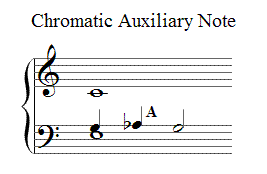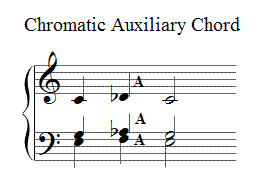APPENDIX A: VOICE LEADING OVERVIEW
The Chromatic Auxiliary Note and the Chromatic Auxiliary Chord
In the strict counterpoint of the 16th century auxiliary notes were usually diatonic, moving a tone or semitone away from a consonant note and returning to the same note. Occasionally B and E's were flattened, effectively forming chromatic auxiliary notes, even in that period. However, in tonal music the scope for the use of chromatic auxiliary notes was much greater; they could be used on any note. The example below shows a chromatic auxiliary note in one part:

This temporarily creates an augmented 5th chord (Ab, C, E) but this immediately returns to the C chord.
Just as diatonic auxiliary notes can be combined in more than one part, chromatic auxiliary notes can be combined. If we also add a chromatic auxiliary note to the top voice and a diatonic (semitone) auxiliary note to the bass then we get the following:

This produces a complete triadic chord - Db (in first inversion). This is usually referred to as the Neapolitan chord. However, this is not a root movement as it arises totally out of voice leading. The Db chord serves only to decorate or prolong the underlying C major harmony. This chord movement usually occurs in first inversion to avoid the parallel 5ths that would otherwise arise. As this combination produces a full triadic chord, this can be described as a Chromatic Auxiliary Chord.
Chromatic auxiliary notes may also descend a semitone.
See Book Chapter 3 Part 2 for more details on auxiliary notes and auxiliary chords.
Next Topic: Chromatic Linear Progressions

